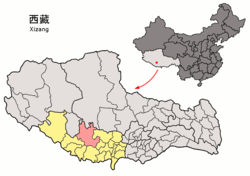

Ngamring County
昂仁县 • ངམ་རིང་རྫོང་།
| |
|---|---|

Jucang Village along the G219 highway
| |

Location of Ngamring County (red) within Xigazê City (yellow) and Tibet
| |
|
Location of the seat in Tibet Show map of TibetNgamring (China) Show map of China | |
| Coordinates: 29°16′22″N 87°10′57″E / 29.27278°N 87.18250°E / 29.27278; 87.18250 | |
| Country | China |
| Autonomous region | Tibet |
| Prefecture-level city | Xigazê |
| County seat | Kagar |
| Area | |
| • Total | 28,205.88 km2 (10,890.35 sq mi) |
| Population
(2020)[1]
| |
| • Total | 55,108 |
| • Density | 2.0/km2 (5.1/sq mi) |
| Time zone | UTC+8 (China Standard) |
| Website | www |
| Ngamring County | |||||||
|---|---|---|---|---|---|---|---|
| Chinese name | |||||||
| Simplified Chinese | 昂仁县 | ||||||
| Traditional Chinese | 昂仁縣 | ||||||
| |||||||
| Tibetan name | |||||||
| Tibetan | ངམ་རིང་རྫོང་། | ||||||
| |||||||
Ngamring County (Tibetan: ངམ་རིང་རྫོང་།; Chinese: 昂仁县) is a county of Xigazê in the Tibet Autonomous Region, China. "Ngamring County, sometimes referred to as the gateway to Mount Kailash and Far West Tibet, is the barren area which divides the Raga Tsangpo and the Brahmaputra."[2]
The office place of the county is located in Kagar, population 1,700, at an elevation of 4,380 m (14,370 ft).[3][4]
Ngamring County is divided into 2 towns and 15 townships.
| Name | Chinese | Hanyu Pinyin | Tibetan | Wylie | ||
|---|---|---|---|---|---|---|
| Towns | ||||||
| Gegang Town (Kagar, Kaika) |
卡嘎镇 | Kǎgā zhèn | གད་སྒང་གྲོང་རྡལ། | gad sgang grong rdal | ||
| Sangsang Town | 桑桑镇 | Sāngsāng zhèn | བཟང་བཟང་གྲོང་རྡལ། | bzang bzang grong rdal | ||
| Townships | ||||||
| Darog Township | 达若乡 | Dáruò xiāng | རྟ་རོག་ཤང་། | rtag rog shang | ||
| Goin'gyibug Township | 贡久布乡 | Gòngjiǔbù xiāng | དགོན་སྐྱིད་སྦུག་ཤང་། | dgon skyid sbug shang | ||
| Comë Township | 措迈乡 | Cuòmài xiāng | ཚོ་སྨད་ཤང་། | mtsho smad shang | ||
| Xungba Township | 雄巴乡 | Xióngbā xiāng | གཞུང་བ་ཤང་། | gzhung ba shang | ||
| Cazê Township | 查孜乡 | Cházī xiāng | ཚྭ་རྩེ་ཤང་། | tswa rtse shang | ||
| Amxung Township | 阿木雄乡 | Āmùxióng xiāng | ཨམ་གཞུང་ཤང་། | am gzhung shang | ||
| Rusar Township | 如萨乡 | Rúsà xiāng | རུ་གསར་ཤང་། | ru gsar shang | ||
| Kunglung Township | 孔隆乡 | Lǒnglóng xiāng | གུང་ལུང་ཤང་། | gung lung shang | ||
| Nyigo Township | 尼果乡 | Níguǒ xiāng | ཉི་སྒོ་ཤང་། | nyi sgo shang | ||
| Riwoqê Township | 日吾其乡 | Rìwúqí xiāng | རི་བོ་ཆེ་ཤང་། | ri bo che shang | ||
| Dobê Township | 多白乡 | Duōbái xiāng | མདོ་སྤེ་ཤང་། | mdo spe shang | ||
| Kairag Township | 切热乡 | Qiērè xiāng | གད་རགས་ཤང་། | gad rags shang | ||
| Qu'og Township | 秋窝乡 | Qiūwō xiāng | ཆུ་འོག་ཤང་། | chu 'og shang | ||
| Dagyu Township | 达居乡 | Dájū xiāng | རྟ་རྒྱུད་ཤང་། | stag rgyud shang | ||
| Yagmo Township | 亚木乡 | Yàmù xiāng | ཡག་མོ་ཤང་། | yag mo shang | ||
The Chung Riwoche Stupa is located on the north bank of the Brahmaputra. "A narrow iron bridge spans the river here, alongside an original iron-chain footbridge attributed to Tangtong Gyelpo,"[2] the founder of Tibetan opera, who was born in Ngamring County. "Legend has it that the iron chain bridge over the Xiongqoi River ... was built with funds collected by Tongdong Gyaibo through performances."[5][6]
Another point of interest is the Ralung Chutse hot spring, which has camping and a guest house.[2]
Zangzang Lhadrak Cave in Ngamring County was where Padmasambhava hid the "Northern Treasures," which consisted of "a number of texts and various sacred objects in a maroon leather casket." These texts and objects were removed in 1366 by Vidyadhara Gödem, and became known as the Dzö Nga (mdzod lnga) or Five Treasuries. The "Northern Treasures" were taught at the Dorje Drak Monastery, and include the Künzang Gongpa Zangtha teachings, a collection of Dzogchen instructions.[7]
Ngamring Monastery[8] or Ngamring Chöde (Wylie: ngam ring chos sde[9] ) produced many important scholars.[10] It was founded in 1225 as a Sakya monastery when "the Ngamring ruler Drakpa Dar (Grags pa dar), also known as Yöntsun (Yon btsun), invited the Sakya master Shākya Sengé (Shākya seng ge) to Ngamring and founded the monastery there."[11]
It was later expanded by the governor Tai En Namkha Tenpa (Ta'i dben Nam mkha' brtan pa, b. 1316) with the assistance of his teacher, the Omniscient Dolpopa Sherab Gyaltsen (Dol po pa Shes rab rgyal mtshan, 1292-1361).[11]
The monastery also followed the Jonang and Bodongpa traditions. It became a Gelugpa monastery at the time of the 5th Dalai Lama. "Tangtong Gyalpo's teacher Ka Ngapa Paljor Sherab (Bka' lnga pa Dpal 'byor shes rab) was the ninth abbot."[11]
|
| |||||||||||||
|---|---|---|---|---|---|---|---|---|---|---|---|---|---|
Lhasa (capital) | |||||||||||||
| Prefecture-level cities |
| ||||||||||||
| Prefecture |
| ||||||||||||
** Southern portions of these counties are claimed by the People's Republic of China as part of the South Tibet area, but are administered by India. | |||||||||||||
|
| |
|---|---|
| Samzhubzê |
|
| Bainang County |
|
| Dinggyê County |
|
| Gyangzê County |
|
| Gyirong County |
|
| Kamba County |
|
| Kangmar County |
|
| Lhazê County |
|
| Namling County |
|
| Ngamring County |
|
| Nyalam County |
|
| Rinbung County |
|
| Saga County |
|
| Sa'gya County |
|
| Tingri County |
|
| Xaitongmoin County |
|
| Yadong County |
|
| Zhongba County |
|